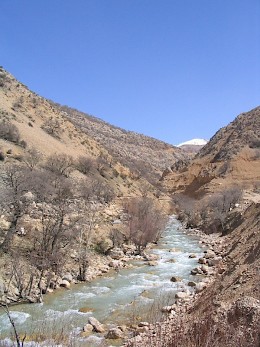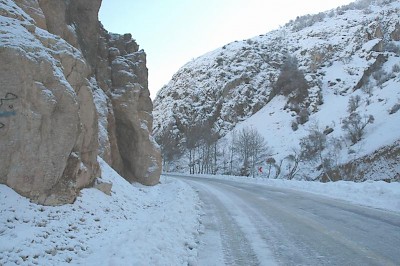Persian Gate (330 BCE)
Q3507255Persian Gate: site along the Royal Road where, in the first days of 330 BCE, the Persian commander Ariobarzanes was defeated by Alexander the Great.

After the battle of Gaugamela (1 October 331 BCE), Alexander the Great conquered Babylonia and Elam. He wanted to invade Persia proper before the winter started. The first part of his route was easy, because a Royal Road connected Susa, the capital of Elam, with the more eastern capitals Persepolis and Pasargadae.

After crossing the river Pasitigris at Šurkutir (modern Shushtar) and rounding up resistance in the area of Masjid-e Solaiman, the Macedonian army was divided near modern Haftgel. Alexander's general Parmenion was to take one half of the army along the Royal road, and the king himself took a more dangerous road through the Zagros mountains. After a tribe of pastoralists, the Uxians, had been massacred, no one dared to obstruct his passage. Without any problems, Alexander crossed the river Marun (the border of Elam and Persis) and reached the plain north of modern Yasuj, which is seen from the northeast on the photo to the left.

Here, the Macedonians prepared themselves for the passage through the Persian gate (Darvazeh-ye Fars), northeast of Yasuj. However, the satrap of Persia, Ariobarzanes, was aware of the movements of the Macedonians and had taken countermeasures. This picture shows the modern road from Yasuj to Isfahan (ancient Gabae). The Gate is to the right, in the valley of a small river named Meyran.

The second map shows the battle in the Persian gate. First, Alexander's army moved into the valley, directly to the east. The Macedonians noticed people on the hills and rocks, but thought that they were refugees. After the massacre of the Uxians, everyone they had met had tried to flee, and the Macedonians expected no difficulties whatsoever now that they were entering an increasingly narrow canyon.
Meanwhile, however, the Persian commander had occupied a position more to the east. This picture shows the probable site of his camp. The village is known as Cheshmeh chenar, "source with pines". It is a little bit further to the east than is indicated on the map of the battle above. This picture was made in May 2005; you must imagine snow, because the battle was fought on ca. 20 January 330.

With the benefit of hindsight, we can say that either Alexander had blundered by forgetting to send scouts into the valley, or that the scouts had been taken captive. There is no other explanation for what happened next.
The valley itself, the Tang-e Meyran, is initially very wide and does not look difficult. It is possible to walk on tracks on both sides of the river. This area is geologically still active: since Antiquity, the river has cut itself deeper into the soil, so back then, the valley must have been less deep.
This picture was taken in February 2004, not far from the sacred place locally known as Baba Hasan. The next pictures were taken in January 2005 and show the snow that must have been there 2335 years before.

Shortly before this rock, which was again occupied by "refugees", the road turns to the right. The Macedonians were now moving to the east-southeast, and could hardly see anything at all, because they were blinded by the rising sun. The road was becoming increasingly narrow. After the rock, a brook empties itself in the Meyran. Almost immediately after the confluence, the road curved to the left. By now, the rear guard had entered the valley as well.

The curve to the left. Not far from this place, the soldiers in the Macedonian front line noticed the wall that had been built by Ariobarzanes. From all sides, Persian soldiers started to throw down stones and rocks; catapults were fired, missiles were thrown. The Macedonians were forced to return, leaving behind their dead. It was the first Macedonian setback after the siege of Halicarnassus, and the last Persian success.

It will be difficult to identify the exact site of the wall. For centuries, big stones and small rocks have been falling down. Recently, this road was constructed. The site has, therefore, considerably changed. The most logical place, however, to build a wall is the narrowest point of the gorge. The photo shows this point on a winter day, about two hours after dawn.
Alexander did not really know what to do, but we are told that a local guide offered his services. This may be true, but the anecdote looks suspiciously like Herodotus's story of Ephialtes, who showed the Persian king Xerxes a road to circumvent Thermopylae in 480.note Whatever the truth, Alexander's men set out during the night and used another valley to turn the pass. This road began near the recently built Shi'ite mausoleum ("Emamzadeh") of Shah Qasem.
Today, and in February, the mountain path is easily accessible. There is a very tiny brook. In January 330, there was snow and ice and we hear about soldiers slipping away, falling down, grasping their comrades, who also started to slip and fall. Fortunately, it was full moon.
After midnight, Alexander's men reached the saddle, where a company of soldiers commanded by Philotas turned to the south. They would arrive at the rock mentioned above. Meanwhile, Alexander continued to the southeast, until they were in the Persian rear.
Descending at dawn, the Macedonians attacked Ariobarzanes' camp. At the same time, Philotas attacked the rock and Craterus marched into the southern valley again.
Many Persians were massacred. Ariobarzanes managed to escape, but was killed before he reached Persepolis. Alexander reached the beautiful palace on one of the last days of January 330. Four months later, he burned it down.
Literature
- Heidemarie Koch, "Die achämenidische Poststraße von Persepolis nach Susa" in: Archäologische Mitteilungen aus Iran 19 (1986) 133-147. [Author uses the Persepolis fortification tablets to reconstruct the Royal road between Susa and Persepolis]
- Henry Speck, "Alexander at the Persian Gates. A Study in Historiography and Topography" in: American Journal of Ancient History n.s. 1.1 (2002) 15-234. [The present webpage is essentially an update of this article.]
Thanks...
... to Henry Speck and Sharona Asghari
Postscript

During my third visit to Yasuj, in May 2005, I had the honor to meet professor Abuzar Hemati, a linguist from the local university. He told me that he had a different interpretation of the battle, which results in a different location, between Kopan and Yasuj. His arguments are:
- The road between Kopan and Yasuj has been the site of similar battles between the local population (Luri nomads) and invading armies. It is a well-known place to trap regular armies.
- There are three topographical names in the Kopan/Yasuj area that may have been derived from names commemorating the battle:
- Tangeri << Tang-e Ariobarzan ("valley of Ariobarzanes")
- Dashterun << Dasht-e Rumi ("desert of the Rumi", the name used to describe Alexander in the Zoroastrian text known as the Book of Arda Wiraz, a description of a vision of heaven and hell by a religious scholar who wrote commentaries on the Avesta in the third or fourth century CE).
- Gujestan may be derived from Alexander's pejorative title Guzastag, "the accursed".
Professor Hemati published his theory in an Iranian journal that I have not been able to read. It would be unfair to criticise this identification. However, Mr. Hemati assumes that the battle was fought by local nomads under a Persian commander, something that is contradicted by the fact that Curtius Rufus mentions that Alexander's enemies employed catapults, which is hardly a weapon used by pastoralists.
Although I have some reservations about professor Hemati's theory, I think it is important enough to mention. And whatever our differences of opinion, there should be a statue of Ariobarzanes in Yasuj.
- A. Hemati, "Shenasai-e Darband-e Pars. Mahall-e Nabard-e Aryo Barzan Sardar-e Rashid-e Irani wa Eskandar-e Maghduni" in: Tarkh-e Ilat-e Fars 2, 106-134 ("Investigating the Persian Gate, the site of the battle between the brilliant Iranian general Ariobarzanes and Alexander the Great" in History of the Nomads of Fars.)